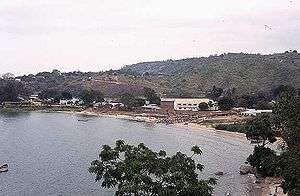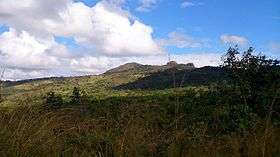Mtwara Development Corridor
The Mtwara Development Project is a major infrastructure development project involving southern Tanzania, northern Mozambique, eastern Malawi and Eastern Zambia. The goal of this project is to provide road, rail and waterway access from the surrounding region to the Port of Mtwara.[1] The region and the corridor has been neglected by the respective governments for over 40 years and the recent discovery of oil, gas and various minerals has kick started the development of the project.[2] A road and rail link is to be built from the port of Mtwara to Mbamba Bay on Lake Nyasa to link Malawi to the corridor and further road links into Mozambique will facilitate access to northern Mozambique.[3]

History
The talks of the project began during the early 2000s where leaders of the 4 SADC community members met to create a shorter/alternative path for cargo into the region from the Dar es salaam port. The last time the region saw a major infrastructure investment was during the colonial times. The Mtwara port and a minor railway link was developed during the British colonial times as part of the failed Tanganyika groundnut scheme.[4] Post colonial times the south of Tanzania had seen very little development and was often neglected in infrastructure projects as the region brought very little revenue to the coffers.[5]
In late 2004 the leaders of the four participating countries; Benjamin Mkapa (Tanzania), Joaquim Chissano (Mozambique), Bingu wa Mutharika (Malawi) and Levy Mwanawasa (Zambia) managed to sign a Memorandum of Understanding to make the Mtwara Development Corridor a reality. The aim of the corridor was to create competitive transport links for the region to help boost the informal and formal industry. The project was to help regional integration to facilitate growth in agriculture, fisheries, tourism and the mining sector. The development project involved building and rehabilitating over 800 km of roads and involved the construction of Unity Bridge. Furthermore, the ports of Mtwara and Mbamba Bay were to be upgraded to handle high volumes of cargo.[6]
2016
To help boost business in the area the Tanzania Ports Authority embarked on a project to introduce three new ships into Lake Nyasa. The authority will buy 2 cargo ships each with a capacity of 1,000 tonnes and one passenger ferry.[7]
Road and rail links
Road

An 804 km road from the port of Mtwara to Songea has a sealed surface already[8]. The onward route through to Mbamba Bay via Mbinga is not all sealed. Furthermore, another road from the Mtwara-Songea highway branches off to the Ruvuma River at the Mozambique border. At the border the Unity bridge was completed in 2010 and Mozambique is to construct a 175 km road from Negomano to Mueda connecting the corridor to Mozambique's highway 246.[9]
Railway construction
With the high amounts of mineral deposits found in the south along the corridor the Government of Tanzania deemed the construction of a railway to be economically feasible. The railway line is to span 1000 km from Mtwara port to Mbamba Bay through Mchuchuma and Liganga areas. The railway line is to cost TZS 8.4 trillion shillings and the Government of Tanzania is looking to implement the project under a Public and Private Partnership (PPP). The railway line will complement all the coal and iron mining operations in Mchuchuma and Liganga and make Tanzanian coal and iron exports more attractive internationally.[2]
Unity Bridge

The Unity Bridge spans across the Ruvuma river from Tanzania to Mozambique. It was a dream of the two former presidents of the country Julius Nyerere of Tanzania and Samora Machel of Mozambique. Plans for the bridge were inked in 2005 and it was completed five years later in 2010. A border post was constructed in Negomano and is the first bridge to span between the two countries. The Bridge was crucial to the Mtwara Development Corridor project as it connected the two major highways in the region and was the key to cross border trade between the countries. The bridge also provides a road link between Mtwara port and Malawi. Plans are underway to create a second bridge, Unity Bridge 2 180 km south of Songea. The bridge would connect Kivikoni in the Songea Rural district, to Lupilichi, Mozambique.[10]
Port infrastructure
Mtwara Port
The port will be accompanied with an export processing zone to help fast track the regional economy and bring in revenue for the port. The special zone saw an investment of over $700,000 in December 2015 from the Dar es Salaam-based firm Alistar Free Ports Limited. Over 100 hectares have been set for an industrial zone and over 400 hectares have been set for oil/gas activities.[11]
Lake Malawi ports

With the development of the road and rail links, the transport corridor can provide an alternative route for goods moving in and out of Malawi. The development plan involves upgrading both Mbamba Bay in Tanzania and Nkhata Bay in Malawi.[12] The project will also involve purchasing high capacity ferries to move cargo and passengers between the terminals.[13]
Economy
Mining operations

Exploration works in Mchuchuma have Liganga concluded that there is over 364 million tonnes of coal and 219 million tonnes of iron ore deposits at the twin projects. These have one of the largest estimates of iron ore deposits in the country and the mines are estimated to operate well over 100 years and will continue to foster and develop the regional economy.[14] The Liganga Mines are also known to be rich in Vanadium and Titanium and its plausibility is still being explored.
Mining operations in the region especially with coal have already kicked off, TANCOAL Energy Limited (a joint venture of NDC and Intra Energy Corporation of Australia) has been conducting coal mining operations in the region and have already started to sell the coal domestically. In 2014/2015 the company managed to extract over 300,000 tonnes of coal and sells most of its coal locally to the domestic cement manufacturers. The construction of the rail link will help export the coal through the Mtwara Port.[15]
The Mchuchuma coal projects are set to begin operations in 2016 as per the Ministry for Trade and Industry. The TZS 5 trillion is project under the Tanzania China International Mineral Resources Ltd (TCIMRL), a joint venture between the National Development Corporation (NDC) and the Chinese firm Sichuan Hongda Group. It is categorized as the largest single industrial investment since Tanzania was awarded its independence in 1961. The project is expected to create 32,000 direct jobs and will bring Tanzania to being the third largest producer of iron in Africa.[15]
Energy generation
The Mtwara corridor is currently disconnected from the national grid and energy in the region is dependent on outlying thermal power plants. The growing mining operations and the expansion of industry in Mtwara will need reliable energy supply. To power the Coal and Iron operations the state energy firm TANESCO plans to construct a 600MW coal fired power plant of which 250MW will be used by the Iron industry and the remaining 350MW will be fed into the national grid.[15] The recent discoveries of natural gas in the region will facilitate another 600MW gas fired power plant in Mtwara to feed to the nearby region and into the national grid. The power plant project will also involve the extension of transmission lines from Mtwara to Songea to ensure the entire southern region is connected to the grid.[16] The kick off of these projects will bring a massive surplus in energy and in the future, the southern region governments plan to extend the transmission lines into Mozambique and Malawi.[17]
Environmental concerns
The southern part of Tanzania and northern Mozambique are home to vast natural reserves such as the Selous Game Reserve and the Niassa Reserve. The border of Tanzania and Mozambique is drawn by the Ruvuma River and the regions around it has been named the Great Ruvuma Wilderness (GROW) by the wildlife community. The wildness is the last great wilderness of Africa and is home to various important species of large mammals and marine life. Due to large amounts of poverty and lack of development in the area the region's population relies on the natural habitat for survival. The construction of the infrastructure projects have led to various abuses of the natural environment. The construction of the new roads and the Unity Bridge in recent years has increased the amount of illegal logging in the region.[18] The Niassa reserve where the Unity bridge goes through is home to 43% of Mozambique's elephants and in the past three years it has been estimated that 2/3 of the elephants have been lost.[19] The road rehabilitation projects have also caused various unplanned settlements to spring up, interfering with the wildlife's natural movement patterns.[18]
References
- "Mtwara Development Corridor Project, Tanzania, Mozambique, Malawi, Zambia". aurecongroup. Retrieved 26 December 2015.
- "Tanzania: A Railway Line in the South - 40 Years After Tazara". allAfrica.com. Allafrica. Retrieved 2015-12-26.
- Masato, Masato (11 September 2012). "Mtwara Set to Become Economic Powerhouse". Retrieved 26 December 2015 – via AllAfrica.
- "Britain Abandons the Groundnuts Scheme | History Today". www.historytoday.com. Retrieved 2015-12-27.
- "Tanzania: A Railway Line in the South - 40 Years After Tazara". allAfrica.com. AllAfrica. Retrieved 2015-12-27.
- "Four countries, one people, one development corridor: Mtwara". Southern African Research and Development center. Southern African News Features. January 2005. Retrieved 27 December 2015.
- "Ambitious TPA to construct 3 modern ships for Lake Nyasa". ippmedia.com. Retrieved 2016-08-10.
- "Mtwara Development Corridor Study-(Mueda Negomano Road project) (2012-7)". www.nepad-ippf.org. Archived from the original on 2016-01-05. Retrieved 2015-12-27.
- "Prefeasibility And Environmental Baseline Study For The Ruvuma River Interface" (PDF). selous-niassa-corridor.org. Ministry of Trade and Industry (South Africa). 21 August 2005. Archived from the original (PDF) on 4 March 2012. Retrieved 27 December 2015.
- "Tanzania: Dar Firm Injects Sh1.5 Billion in Mtwara's Free Port Zone". allAfrica.com. Allafrica. Retrieved 2015-12-27.
- KITOMARY. "Magufuli with long list of promises". www.ippmedia.com. Retrieved 2015-12-27.
- "Mtwara Port and Economic Development Zone" (PDF). ecfa.or.jp. Engineering and Consulting Firms Japan. Retrieved 27 December 2015.
- "Mchuchuma, Liganga Mines to Last 100 Years". 5 July 2013. Retrieved 27 December 2015 – via AllAfrica.
- "Tanzania: Mchuchuma Coal Mine for Takeoff". allAfrica.com. Allafrica. Retrieved 2015-12-27.
- "Mtwara 600 MW gas power plant transmission to cost USD 1.3 billion". www.ippmedia.com. Retrieved 2015-12-27.
- "CURRENT PLANS FOR REGIONAL TRANSMISSION REINFORCEMENTS IN SOUTHERN AFRICA" (PDF). International Renewable Energy Agency. Retrieved 27 December 2015.
- "WWF Tanzania: Our Solutions". wwf.panda.org. Retrieved 2015-12-27.
- "Vets collar Mozambique elephants in Niassa National Reserve". Times LIVE. Retrieved 2015-12-27.
